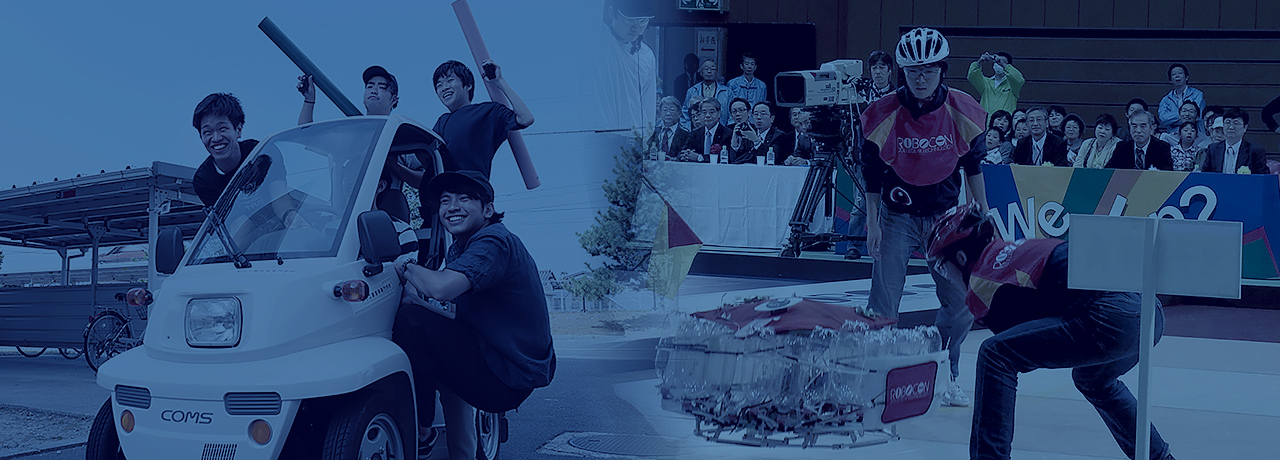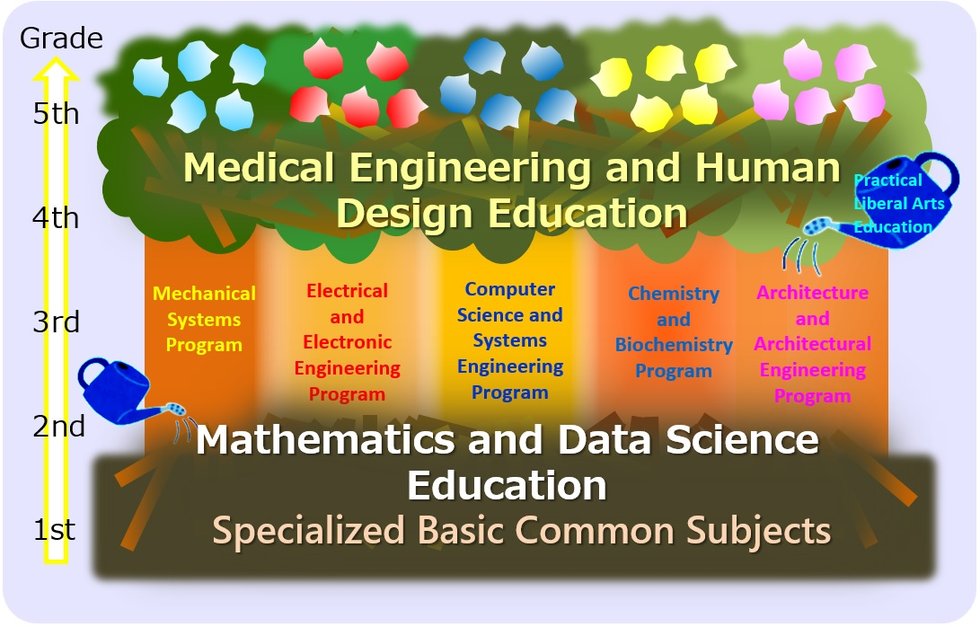
From the Department of Integrated Engineering and its Divisions
Department of Integrated Engineering
The Department of Integrated Engineering’s curriculum guides lower-grade students in acquiring basic knowledge of cross-disciplinary engineering common to all programs. In this way, they deepen their understanding of what is included in each program and gain insight into any future studies after graduation.
Students can see their career paths branching out in front of them and prepare for the specialized program selection in higher grades. At the same time, they learn the basics of mathematics and data science, and experience data processing and analysis through classroom lectures, experiments, practical training, and graduation research.
After laying the groundwork for learning general engineering, students are then divided into specialized programs from the latter half of the second grade. From the roots that have been seeded, the students will sprout and grow into their specialized fields. The techniques that are learned form the roots and the chosen program is the trunk, which continues to be nurtured and grows steadily thicker.
In the upper grades, medical engineering and human design education are taught. Targeting medical care, welfare, and nursing care, the foundations to apply learned expertise and technology to the field of medical engineering are sown, meeting the needs of the region. In addition to the specialized subjects of each program, common specialized core subjects are offered. Students from different fields of study can thus obtain the same knowledge.
Furthermore, in PBL education (project-based learning), teams are organized across grades and majors. The group work aids in developing active learners. As a result, students can further improve their communication skills and acquire a multi-faceted perspective that combines technology and knowledge from various specialized fields.
In addition, practical liberal arts education is provided in all grades to acquire generic skills for utilizing learned knowledge and skills to benefit society. In other words, this is the fertilizer for growth that organically links specialized education, understanding of the local community, gaining an international perspective, and developing ethics and communication skills.
Divisions and Programs
Mechanical Systems Program
In the Mechanical Systems Program, students learn practical skills to design and develop human-friendly mechanical systems by incorporating elements of electrical and electronic engineering, information processing, computers, and ergonomics. The health, safety and welfare of the public, guide the engineering and knowledge and technology related to motion and mechanics such as mechanism, structure, and materials are nurtured.
The program aims to cultivate creative engineers. To effectively train skilled engineers, the subjects necessary for mechanical engineering such as drafting, material mechanics, machine materials, mechanical working, design engineering, fluid engineering, thermal engineering, and mechanics are covered.
At the same time, all grades undertake experiments and practical training courses to gain valuable hands-on experience. Additionally, some subjects are integrated such as Mechatronics and Measurement, and Control Engineering. In the fifth and final grade, graduation research is arranged as a comprehensive subject to showcase all the knowledge and techniques learned.
Electrical and Electronic Engineering Program
The Electrical and Electronic Engineering Program aims to equip students with a basic understanding of technologies related to the generation, transportation, and conversion of electrical energy, electronics, and information and communication. They become familiar with peripheral technologies such as system design and new material development for efficient use of these technologies to benefit all people. The goal is to train practical and creative engineers who can utilize a wide range of electrical technologies to help build a sustainable society.
Training engineers to benefit society requires a broad skillset and students learn electrical and electronic engineering such as electrical circuitry, electromagnetic science, electrical measurement, electrical equipment, electrical engineering, electronic devices, electronic circuitry, and communication engineering.
Complementary to the core learning, experimental and practical training tasks are undertaken. Additionally, subjects such as programming and computer engineering are integrated and interdisciplinary, and in the 4th and 5th grades, electives such as electric power and control systems, and information and communication systems become specialized. In the fifth and final grade, graduation research is arranged as a comprehensive subject to showcase all the knowledge and techniques learned.
Computer Science and Systems Engineering Program
The Computer Science and Systems Engineering Program is focused on developing both practical skills and cultivating creativity. Students can propose and build information systems to advance a technologically integrated society with medical care and welfare in mind. Students learn basic technologies such as computer hardware and software that support an advanced information-based society and embed the systems into people’s lives.
This course is organized with the goal of training proactive engineers. To train the target engineers, the subjects necessary for information engineering such as programming, digital circuitry, computer architecture, algorithm and data structure, software engineering, artificial intelligence, and computer networking are provided.
Furthermore, across all grades, level-appropriate experiments and practical training courses are arranged. Some subjects are integrated and interdisciplinary such as those related to Electrical and Electronic Engineering and Mechanical Engineering. In the fifth and final grade, graduation research is arranged as a comprehensive subject to showcase all the knowledge and techniques learned.
Chemistry and Biochemistry Program
With a basic knowledge of physical chemistry, inorganic chemistry, organic chemistry, analytical chemistry, biochemistry, and chemical engineering, to name some, students acquire new material development techniques and learn technology to apply to biological functions, the environment, food, energy medicine, and health and welfare.
The course is designed with the goal of training practical, creative, and flexible thinking engineers who can work on solving problems in a variety of fields. To nurture the target engineers, applied chemistry such as physical chemistry, inorganic chemistry, organic chemistry, analytical chemistry, biological chemistry, chemical engineering, biological engineering, and material chemistry are covered.
In addition to the range of subjects, experimental and practical elements are undertaken across all grades. Integrated and interdisciplinary courses such as electrical and mechanical training and information engineering are arranged. The 4th and 5th grades see a shift towards specialization in materials and biotechnology. These are organized within the higher-grade subjects. In the fifth and final grade, graduation research is arranged as a comprehensive subject to showcase all the knowledge and techniques learned.
Architecture and Architectural Engineering Program
In addition to the fusion of technology and art from the conventional structural and design fields, the Architecture and Architectural Engineering Program combines information engineering, ergonomics, and welfare engineering. The course aims to cultivate practical and creative engineers who can utilize architectural design techniques and knowledge in response to natural disasters.
In order to train the target engineers, subjects such as structural dynamics, building construction, building materials, building environment,architectural planning, city planning, architectural history, and architectural design are taken. Concurrently, level-appropriate experimental and practical courses, and design and drawing courses are studied.
Additionally, integrated and interdisciplinary subjects are offered such as CAD / CG, which are information engineering units. In the fifth and final grade, graduation research is arranged as a comprehensive subject to showcase all the knowledge and techniques learned.
International Exchange Support Office
In our school, we are actively implementing various international exchange programs aimed at developing global engineers who can play an active role in the global society. Participating in international training helps students understand different cultures and develop a global mindset.
A wide range of training jointly held with the Chugoku Region 8 National College of Technology is also available. The Ministry of Education, Culture, Sports, Science and Technology has set up a scholarship system that provides an exemption of fees (Tobitate! (Leap for Tomorrow) Study Abroad Initiative). Our school is also actively accepting international students from Southeast Asian countries such as Malaysia and Mongolia, and has accepted 98 international students from 14 countries so far!

